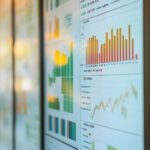Zennemis – Imagine if the secret to finding hidden patterns in your data is in the connections between things, not just the data itself. More companies are now using graph analytics for big data, changing how they see their data. This method uses data visualization and network analysis to find important insights in complex data.
Graph databases store data as connections between entities, not just in tables. This lets us use knowledge graphs to unlock new insights. We’ll look into how graph analytics helps with fraud detection, social network analysis, and improving operations. Let’s see how graph analytics can change how we make decisions and improve our work.
Understanding Graph Analytics
Graph analytics is key for looking at complex data with many connections. It helps companies make better decisions by finding patterns in their data. This method is vital for understanding networks like supply chains, social media, or crime networks.
Definition and Importance
Graph analytics studies data in a graph format, where nodes are entities and edges show their connections. It finds patterns and insights not seen in traditional analysis. Graphs make complex data easy to understand.
This helps in many fields like healthcare, finance, and cybersecurity. It shows how big data analysis with graphs can improve performance.
Comparison to Traditional Data Analysis
Traditional analysis uses tables and focuses on single variables. But, it might miss important connections. Graph analytics looks at relationships, giving deeper insights.
This method is more like real-world connections. Traditional methods might overlook key relationships, putting companies at a disadvantage.
Advantages of Using Graph Structures
Graph structures have big benefits. They make finding data fast and efficient. They also support adding more attributes and natural language processing.
Graph databases can handle new data easily, which is great for machine learning. This leads to better analysis and strategic decisions.
| Feature | Graph Analytics | Traditional Data Analysis |
|---|---|---|
| Data Structure | Nodes and Edges | Tables and Rows |
| Relationship Handling | Focus on Interconnections | Independent Variables |
| Analysis Complexity | Handles Complex Relationships | Simple Relationships |
| Adaptability | Flexible with New Data | Rigid Structure |
| Performance | High Query Performance | Slower Querying |
Graph Analytics for Big Data: Techniques and Applications
Graph analytics looks into data structures where relationships matter a lot. It uses queries to find insights about connections and behavior. Techniques like analyzing node strength and edge significance help us understand these connections better.
This section will explore these methods and their uses in different areas.
How Graph Analytics Works
Graph analytics checks out the relationships in a graph structure. It uses data mining to spot patterns and predict behaviors. Modeling complex data as a network helps us understand big datasets better.
Methods like finding groups and spotting odd patterns are key. They help us see what’s normal and what’s not in the data. This info helps predict trends and make better decisions.
Real-World Use Cases
Graph analytics is used in many fields. In social networks, it finds influencers and shows how people connect. Bioinformatics uses it to map biological networks, helping us understand complex life processes.
In cybersecurity, it spots fraud by looking at relationships between people and devices. It helps plan better routes and improve traffic systems, showing its wide use.
Data Mining Techniques in Graph Analytics
Data mining boosts graph analytics by finding important insights. Link prediction predicts future connections from current data. Using machine learning with graph models gives us better predictions.
This helps businesses make smart moves and act fast in complex situations. Graph analytics gives a competitive edge by offering deep insights into customer behavior and operations.
Tools and Technologies for Graph Analytics
In the world of big data analytics, picking the right tools and technologies for graph analytics is key. Many platforms offer unique features. They help businesses manage big datasets and see complex connections.
Popular Graph Analytics Platforms
Several top graph analytics platforms are popular with companies. They aim to use their data fully. Here are a few key ones:
| Platform | Key Features | Best Use Cases |
|---|---|---|
| Neo4j | Native graph storage, powerful query language (Cypher), and rich visualization tools | Fraud detection, social network analysis |
| Apache Spark GraphX | Integrated with Spark ecosystem, supports graph-parallel computations | Large-scale graph processing, iterative algorithms |
| GraphDB | Supports RDF data and SPARQL querying, semantic graph capabilities | Knowledge graphs, linked data applications |
Each platform meets specific business needs. Choosing the right graph analytics platform is crucial for successful big data analytics projects.
Machine Learning Algorithms in Graph Databases
Adding machine learning algorithms to graph databases boosts data analysis. These algorithms work well with graph structures. They help pull out important info about connections between entities.
This leads to better predictions and helps with tasks like:
- Path analysis: Finds the shortest paths, great for supply chain optimization.
- Centrality analysis: Shows which nodes are most important in social networks.
- Community analysis: Finds nodes that belong together in groups.
- Similarity analysis: Points out nodes that are similar, possibly linked to the same thing.
- Link prediction: Guesses new connections between nodes.
- Graph embeddings: Gives nodes vector representations for better machine learning models.
Using these advanced methods helps spot anomalies and analyze relationships better. This opens up more possibilities in a data-driven world. As companies deal with complex data, picking the right graph analytics platforms and machine learning algorithms is vital.
Trends and Innovations in Big Data Analytics
The world of big data analytics is changing fast, thanks to new trends and innovations. Graph analytics for big data is a big step forward. It changes how we make predictions. Now, companies can make more accurate forecasts, which helps in many areas like marketing and risk management.
Impact on Predictive Modeling
More companies are using graph analytics to improve their predictive modeling. In 2023, 63% of those familiar with AI and machine learning plan to spend more on these areas. This shows how important analytics tools are for getting clear insights. Analyzing complex data is key to making good strategies.
Emerging Big Data Analytics Trends
Data management is changing, and new trends in big data analytics are emerging. Edge computing makes data processing faster and cheaper. AI and graph analytics are changing how industries like retail and healthcare use data from things like voice assistants and IoT devices. Companies are moving to new data storage methods like data lakes for better data handling.
| Trend | Description | Implications |
|---|---|---|
| Edge Computing | Reduces network reliance, enabling faster analysis and response | Cost savings, improved performance |
| AI and ML Integration | Enhances analytic capabilities through intelligent insights | Increased efficiency and smarter operations |
| Data Lakes | Storage solutions for structured and unstructured data | Flexibility in data management |
| Graph Analytics Adoption | Uses relational data to drive decision-making | Greater contextual insights, enhanced strategies |
These trends show a move towards more flexible and insightful ways of using big data analytics. Graph analytics is key in this shift. By adopting these trends, companies can stay ahead and keep a competitive edge.
Conclusion: Graph Analytics for Big Data
Graph analytics for big data is a game-changer. It helps us understand complex relationships in large datasets. This leads to better decision-making and more efficient operations. It’s used in many areas, like social network analysis and fraud detection, showing its wide impact.
Graph analytics also changes how we see data by showing complex relationships. It gives us a big edge in strategy. We’ve learned that different data types need specific analysis. Using the right software and skills is key to handling big data.
As data grows, using graph analytics will be key to getting the most from big data. By combining graph theory, statistics, and machine learning, we can unlock more value from our data. This leads to smarter and more responsive organizations.
FAQ: Graph Analytics for Big Data
What is graph analytics and why is it important for big data?
Graph analytics looks at data in a special way, using nodes and edges to show connections. It’s key for big data because it helps find hidden patterns. This leads to smarter decisions and better efficiency.
How does graph analytics differ from traditional data analysis?
Graph analytics focuses on how data points connect, unlike traditional analysis which looks at them alone. This method gives deeper insights, making it great for predicting trends and understanding complex data.
What are the advantages of using graph structures for data analysis?
Graph structures make queries faster and let you add more details easily. They also work well with natural language processing. This makes complex data easier to understand and visualize, leading to better business insights.
Can you explain some techniques used in graph analytics?
Key techniques include finding groups, predicting links, spotting oddities, and grouping similar data. These help highlight important patterns and relationships, guiding smarter decisions and improving predictive models.
What are some real-world applications of graph analytics?
Graph analytics helps in many areas, like finding key influencers, making product suggestions, and fighting fraud in finance. It shows how entities connect, helping companies make smarter marketing moves and engage customers better.
What are some popular platforms for graph analytics?
Top platforms for graph analytics are Neo4j, Apache Spark GraphX, and GraphDB. They’re great at handling big data, doing complex queries, and making data easy to see.
How can machine learning enhance graph analytics?
Machine learning boosts graph analytics by improving how it analyzes connections. These algorithms help predict outcomes better and spot unusual patterns, opening up more uses in business.
What are the current trends in big data analytics related to graph analytics?
Trends include combining AI and machine learning with graph analytics. Real-time data processing is also key, pushing graph analytics to stay competitive in the data world.




